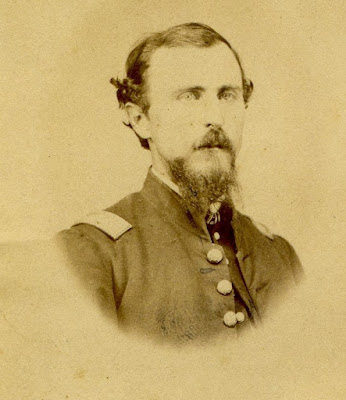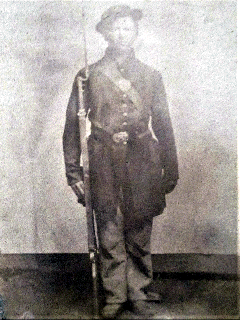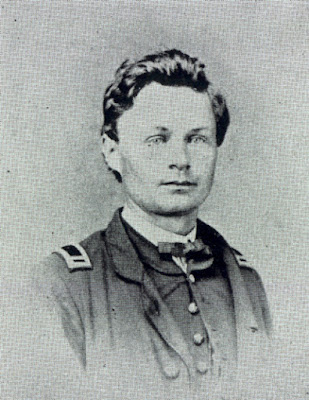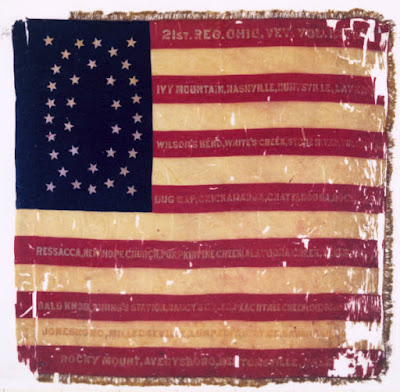The Heavy Work is Done: Mustering Out the 21st Ohio Infantry
One can only imagine the
thoughts of Captain Jacob L. Keller of the 21st Ohio as he and his comrades
steamed placidly down the Ohio River on June 12, 1865. It was the second time
the Buckeye officer had taken a steamboat ride upon the Ohio River with the
regiment; the first time was in November of 1861. “The trip down the river was
much more pleasant than the one from Catlettsburg, Kentucky in the winter of
1861,” he later wrote. “Then it was stormy and cold- now it was splendid summer
weather. Then the heavy work was before us- now it was done. It seemed as
though all in nature conspired to make our return trip home pleasant. The sight
of the hills of our dear Ohio cheered us, and steamboat captains did what they
could to make the trip downriver pleasant.”
 |
| Captain Jacob L. Keller, Co. A, 21st O.V.V.I. "Then the heavy work was before us- now it was done." |
The
“heavy work” of four years’ service included playing key roles in some of the
most crucial battles of the western theater, including the regiment’s steadfast
defense of Snodgrass Hill at Chickamauga and its ferocious fight in the
Slaughter Pen at Stones River. The tracks of the regiment’s marches and battles
were marked with the dead: 172 of them killed or mortally wounded in battle while
another 220 died of disease. They were buried in the numerous states of the old
Confederacy and from New York in the east to Iowa in the west. Dozens of the
men lost their lives in the Confederate prison camps and some were tragically
lost aboard the Sultana when it exploded on the Mississippi River in
April 1865. There were nearly 1,000 men on that first trip on the Ohio River in
1861; now barely 300 remained in the ranks and a large number of those were
recruits who joined up when the regiment went home on veteran’s furlough in
early 1864.
The sharp
rasp of the 21st Ohio’s .69 caliber Greenwood-altered U.S. Model
1842 rifle muskets first resounded at Ivy Mountain in November 1861,
then later barked with a deafening roar in the Cedars at Stones River. In the spring of 1863, the regiment traded in their trusty Greenwood’s for
more modern hardware, the .56 caliber Colt Revolving Rifle which they used with
such deadly effect at Chickamauga, firing more than 43,000 rounds of ammunition
on that memorable September 20th of 1863. Later that fall, the
deadly if tricky Colt’s were traded in for a complete allotment of superb
English-made Enfield rifle muskets that the regiment carried for the rest of
the war.
The
regiment participated in many a battlefield of the Atlanta campaign but perhaps
most memorably at Vining’s Station where the regiment suffered its highest
losses of the campaign, including my own great-great-great-great uncle who suffered
the second wound of his army career, this one ending his active service. The
March to the Sea followed the capture of Atlanta then the march through the
Carolinas which culminated in the regiment’s final battle at Bentonville, North
Carolina in March 1865. Then the march through Virginia and participation in
the Grand Review in Washington, D.C.
The
regiment’s leadership featured some of the most memorable characters the state
produced during the war. Their first colonel Jesse S. Norton was severely
wounded and captured at Scary Creek in July 1861 but got a little
too cozy with Alabama secessionists in the summer of 1862 and embroiled himself
in the ugly high command politics of the Buell era, and ultimately left the
regiment a forgotten and misunderstood man.
 |
| Colonel James Neilbing, 21st O.V.I. The beloved "Colonel Jim" |
The
regiment’s next commander, the courageous, high-spirited and freewheeling James
Neibling of Findlay, familiarly known as “Colonel Jim,” led the 21st
Ohio to glory at Stones River by commanding the men to “give them hell by the
acre, boys, hell by the acre.” Neibling’s lax discipline led to scads of
trouble for the regiment in the spring and summer of 1863. Colonel Jim was home
in Ohio when the more disciplined Dwella Stoughton, who the men nicknamed “Roll
Call” for his propensity to frequently call the roll to keep the men in line,
took the regiment up Snodgrass Hill that late September afternoon and helped
write the regiment’s name into the annals of history. Riding behind the lines
wearing a yellow cloak and encouraging his men to fight, a Confederate sharpshooter’s
bullet cut into his left arm near the shoulder joint which prompted Stoughton
to pronounce, “I think this will use me up.” And it did, two months later in
Findlay.
This
gave the command to Major Arnold McMahan of Perrysburg. A disciplinarian and
fierce fighter, McMahan led the defense of Snodgrass for the rest of the
afternoon and was there at the end when the Confederates closed in and captured the 135 survivors near nightfall. Doc Jones of Co. I saw McMahan the next
morning “sitting with his head bowed and resting on his hand, a perfect picture
of despondency. ‘Major, how does this strike you?’ he asked. ‘Isn’t this hell,”
McMahan responded sadly. And for the next six months McMahan lived the hell of
life in the Confederate prisoner of war camps leaving command of the regiment
for a time in the hands of Captain Charles Vantine of Co. I.
 |
| Lieutenant Colonel Arnold McMahan, 21st O.V.I. |
By the spring
of 1864, Colonel Neibling had returned to the regiment but he didn’t stay long
before he was lost his right arm to a cannon ball at Pickett’s Mill on May 28, 1864,
which again gave the command to now Lieutenant Colonel McMahan. McMahan would
lead the regiment for nearly the entire rest of the war and was the commanding
officer of the regiment when it mustered out of service July 25, 1865, at
Louisville, Kentucky.
Private
Jacob Adams of Co. F, who was with the regiment from pillar to post, recorded
the events of the regiment’s final days of service in his diary. “Monday, July
24th. Our muster rolls completed, we struck tents and bid good-bye
to camp life and headed for Columbus, Ohio where we were to receive our final
pay and discharge. Our regiment marched down to the boat landing at Louisville
where at 2 p.m. we boarded the steamboat America and moved up the Ohio River for
Cincinnati where we arrived Tuesday at noon. We marched up to the Cincinnati
depot where after waiting an hour we boarded the ever-ready stock cars, though
we were not so crowded as we were from Washington. We had pretty clean straw to
lie down on and yet we did think our own state might have furnished better
accommodations for us after serving so long. We arrived at Columbus at 8 p.m.
and put up for our stay at Tod Barracks.”
Three
days later, the regiment gathered into line one last time to hear Colonel
McMahan’s final orders.
General Orders No. 16
Headquarters, 21st
Regiment, O.V.I., Columbus, Ohio
July 25, 1865
Comrades,
Our
services are no longer required. Through the Providence of God, our efforts to
sustain the government and to perpetuate it have been successful. We have
humbled a proud, cruel, and vindictive foe. Thank God we are free, and have the
power to demonstrate for all whom it may concern that all men are born free,
that they are endowed by their Creator with certain inalienable rights among
which are life, liberty, and the pursuit of happiness.
The
pillars of our popular government are strengthened and adorned by the blood of
our honored and lamented dead. The bones of our comrades are upon the fields or
more than 31 well-contested battles. We will remember them kindly and extend to
their families and friends the hand of a brother and true friend.
In parting
with you, my comrades, I congratulate you that you have escaped the casualties
of war to behold the splendor of your achievements. As my military family is dispersed,
my best wishes will follow you to your quiet homes.
Arnold McMahan,
Lieutenant Colonel, commanding
Official: Geo. Scheets, 1st
Lieut. And Adjutant
As
the men stood in line, they could only mark the contrast of how they looked
back in September 1861 when 1,000 of northwest Ohio’s sturdy pioneers presented
their company flags and took the oath at Camp Vance in Findlay. Those original colors
were long gone, either sent home as frayed and scarred relics of war or
captured by their enemies at Chickamauga. There were only 286 of them in the
ranks now; the companies which once numbered 100 men had been shaken and
dwindled down to the point that Companies H and I only mustered 21 men apiece
while lucky Co. F mustered all of 41. The missing spots in the ranks emphasized
the cost of war to everyone present, the brothers of the regiment feeling it perhaps
most poignantly of all. In my own family, Fred McLargin stood in the ranks of
Co. C carrying two Confederate bullets but he made it out alive. His older
brother James, shot through the head at Stones River while Fred was in parole
camp in Ohio, died of his wounds in 1863. Fred’s story, sad as it is, was
hardly unique in the 21st Ohio.
 |
| Adjutant George Scheets, 21st O.V.I. |
George
Scheets, then serving as McMahan’s adjutant, had to chuckle to think back on
how it all started back in September 1861. Scheets was clerking for W.I.
Hitchcock’s store in Perrysburg when McMahan came back from the 90-day service
with the 21st Ohio in western Virginia aiming to recruit a company
of three-years’ volunteers. “That night I didn't go to sleep very easy and was
debating in my mind "what of the morrow." When the morning came and I
saw the boys gathering at the Baird House, my mind was made up, and leaving a
hastily written note on my desk for my employer (he hadn't come to the store
yet), bade the other clerks good-bye and joined the boys at the hotel.” A few
weeks later, the regiment was standing in line for examination by Captain E.
Morgan Wood when Wood spotted Scheets and “objected to me on account of size
and muscle (I weighed 120 pounds), but Captain McMahan assured him that I was
all right, as he had a special place for me. (I wondered what position he would
give me.) I assisted the captain as his secretary in making the original muster
roll of his company at the Reid House and was consulted to a certain extent in
the selection of his non-commissioned officers. The selection proceeded. First
the sergeants, then the corporals, keeping right on until the number was
complete. My name was placed in alphabetical order among the high privates.” Little
did either man know that when the chance came, McMahan would indeed have a
special place for George Scheets. Upon the mustering out of the able Edward
Baird in late 1864, Colonel McMahan chose Scheets to serve as his adjutant, and
it was Scheets who set in type and distributed the final General Order for the
regiment as noted above.
With
McMahan’s words of parting ringing out, the men fell out to receive their final
pay and release to return to their homes. “At 1 p.m., the paymaster commenced
paying off our regiment and by 2 p.m. I had my money and my discharge in my
pocket and felt some like a white man,” Jacob Adams recalled. “The next morning
at 7 a.m., I took the train for Findlay, Ohio changing cars at Urbana. After
waiting some three hours, I took the 12:40 train for Carey where we arrived at
3 p.m. and was from that time to sundown running (or rather poking) from there
to Findlay. I soon started on foot for home, walking eight miles, and by 11:30
p.m. I arrived at Father Dorsey’s two miles west of Van Buren.”
The
Hancock Jeffersonian newspaper which had for years so dutifully reported
the news of their “boys” in the 21st Ohio, scarcely noted the
regiment’s return home. “The 21st no longer exists,” it reported on
August 4, 1865. “The good old regiment has been mustered out and the boys
belonging to this county, about 200 in number, have all arrived at home. There
was an immense crowd at the depot to greet them. All honor to the surviving
21sters.”
Below is
the roster of all of the men who mustered out with the regiment at Louisville
on July 25, 1865. The regiment was paid and officially released from all duties
on the afternoon of July 28th at Tod Barracks in Columbus, Ohio.
Ironically, the regiment was mustered in by an officer of the 15th
U.S. Infantry in 1861 and mustered out by another officer of the 15th
U.S. in July 1865. The regiment was no doubt familiar with the 15th
U.S. as they served in the same corps for much of the war.
Field & Staff (5)
Lieutenant Colonel Arnold
McMahan
Surgeon Daniel S. Young
Adjutant George Scheets
Quartermaster Sergeant Joseph
Power
Commissary Sergeant Henry H. Van
Camp
 |
| Sergeant Erastus Biggs, Co. A, 21st O.V.I. Died of wounds at Stones River |
Company A (27)
Captain Jacob L. Keller
First Lieutenant David
McClintock
First Sergeant Squire J. Carlin
Sergeant John Ward
Sergeant Samuel Pickett
Sergeant Lycurgus Williams
Sergeant Abraham Brown
Corporal James Mertz
Corporal Philip Newman
Corporal Stephen Leonard
Corporal Russell Kinion
Corporal Solomon Wells
Corporal Asa Babcock
Corporal James B. Morrison
Private David Beard
Private Jacob A. Coons
Private Perry O. Drake
Private George Ernst
Private Rufus Fellers
Private Sylvester Hawkins
Private John Helms
Private Ambrose J. Marvin
Private George R. Marvin
Private John J. Nusser
Private Thomas Stroub
Private Thomas Twining
Private Frederick G. Worsley
 |
| Private Abraham Courtwright, Co. B, 21st O.V.I. |
Company B (28)
Captain Samuel F. Cheney
Sergeant Philip Willich
Sergeant Washington Swank
Sergeant Valentine Hardy
Corporal Rufus Crossley
Corporal John Godfrey
Corporal Jacob Krouse
Corporal Wilson S. Swank
Corporal Robert Tinneman
Private George W. Bushong
Private Benjamin Davis
Private Henry Folk
Private Perry Fellers
Private Stephen George
Private John C. Hall
Private John C. Helt
Private Absalom Keel
Private Martin Kibler
Private Wellington Krouse
Private John H. Lamb
Private Alpheus Morgan
Private George Mull
Private John Mull
Private Charles Shine
Private Henry Vannatta
Private Jacob Walters, Jr.
Private John Watt
Private John C. Wickham
 |
| Sergeant (later Private) Reason Bates, Co. C, 21st O.V.V.I. |
Company C (27)
First Sergeant Henry Grahlman
Sergeant Thomas Crooks
Sergeant Oramill Forbes
Sergeant Lewis Kingfield
Sergeant Lyman Wilson
Corporal Edgar Price Clough
Corporal Samuel Cooley
Corporal Nicholas Dienst
Corporal Henry H. Houston
Corporal Frederick Nevinberger
Corporal David Plemon
Private Reason Bates
Private John Finkbeiner
Private John F. Harman
Private John Helpman
Private George Havil
Private Robert Litbrick
Private Isaac Longbrick
Private James Lundy
Private Frederick McLargin
Private William Norris
Private William Nurnberger
Private John D. Price
Private Christopher Scheets
Private John Shaw
Private John C. Webb
Private John A. Woods
Company D (32)
First Lieutenant Christian B.
Sholty
First Sergeant Celestine
Crochard
Sergeant Quincy A. Randalls
Sergeant Myron Washington
Corporal William Bunne
Corporal Aaron Gingery
Corporal David H. Randalls
Corporal Lewis Weber
Private Elisha Buckley
Private Thomas Bunn
Private Joseph Bushong
Private Daniel Carr
Private Spencer Croshaw
Private Madison Darron
Private Daniel H. Dunham
Private Joseph Dunham
Private Perry Erb
Private William Folk
Private Edward Kelsey
Private John F.H. Klinefelter
Private John Nelson
Private Awrista Perry
Private Aaron Rice
Private Levi A. Rice
Private Seth Rice
Private Anson Rosecrans
Private David R. Rouston
Private William T. Strother
Private Jacob Thuston
Private Daniel Wagoner
Private Edmund P. Williams
 |
| Lieutenant John Mercer, Co. E, 21st O.V.I. atop Lookout Mountain |
Company E (34)
Captain William B. Wicker
First Sergeant William J. Henry
Sergeant Finlay Britton
Sergeant Horace Ginter
Corporal Marion Cox
Corporal Jacob W. Dowell
Corporal Peter Foust
Corporal Peter Huffman
Corporal Charles C. McConkey
Corporal Hiram Sweet
Private Joseph Beerbower
Private George W. Boyles
Private Chester Bronson
Private Anson Christie
Private William Coulter
Private Edward Crawford
Private George Ferry
Private Simon W. Fish
Private William Forian
Private William Freedline
Private Alfred Ginter
Private William Ginter
Private Charles Godfrey
Private Appleton Hopkins
Private Anthony W. Miller
Private Lafayette Miller
Private George W. Moore
Private William C. Powell
Private John Saltzman
Private William A. Shatto
Private Milton Sheen
Private David Spindler
Private John R. Spindler
Private Jesse D. Tracy
 |
| Private Christian D. Bare, Co. F, 21st O.V.V.I. |
Company F (41)
First Sergeant Robert F. Bonham
Sergeant Eli W.L. Alspach
Sergeant Alfred Larkins
Sergeant John Lamott
Sergeant Jeremiah E. Milhuf
Corporal John B. De Haven
Corporal Andrew S. Kelley
Corporal George Kelley
Corporal William B. Morehead
Corporal Jesse Walters
Corporal Ralph C. Watson
Musician Maion F. Beals
Musician William W. Latham
Private Jacob Adams
Private Christian D. Bare
Private Jeremiah Bolten
Private George Carr
Private Henry Davis
Private Philip Dietz
Private Charles Edwards
Private Noah Fellers
Private George Fenstermaker
Private Nathan Greer
Private George F. Hammond
Private John F. Hampton
Private Eli Hook
Private David Huffman
Private George Kibler
Private James M. Latham
Private Jacob Oman
Private Napoleon B. Plotner
Private Gideon Powell
Private John H. Powell
Private Peter F. Powell
Private John T. Reed
Private James E. Scott
Private George W. Shoemaker
Private Robert Smalley
Private Joseph Vaughn
Private John Wolf
Private Jackson Yates
 |
| Lieutenant John Bolton, Co. F, 21st O.V.V.I. |
Company G (28)
First Sergeant Robert F.
McDonald
Sergeant Samuel L. Burman
Sergeant Jonathan Fast
Sergeant Henry B. Thomas
Corporal Uriah E. Bearse
Corporal John A. Davis
Corporal Joseph McKinsey
Corporal Jeremiah Shoemaker
Private William G. Bond
Private John H. Copus
Private James Crosser
Private Joseph W. Cumerine
Private William W. Davis
Private Henry J. Daymeger
Private Christian Diehl
Private Charles W. Doolittle
Private John C. Fackey
Private Isaiah Frick
Private David Green
Private Solomon Hicks
Private Laz Hockenberger
Private Ephraim Kelley
Private John P. Leiter
Private William Pohner
Private Samuel Seitz
Private Collins Shilling
Private Seth W. Shoemaker
Private Eli C. Thomas
Company H (21)
First Lieutenant Augustus
Besanson
First Sergeant Christopher
Grundy
Sergeant Eugene Brisbin
Sergeant Lafayette Hale
Sergeant Henry R. Skinner
Corporal George W. Barber
Corporal Jonas W. Daish
Corporal Silas S. Daish
Corporal Edward Knifer
Corporal William Middleton
Corporal Jacob Swartwout
Corporal Isaac Van Valkenberg
Private William Brookman
Private Daniel M. Brown
Private Edson G. Daish
Private Sylvester T. Everett
Private William H. Long
Private Reuben G. Pepple
Private Samuel F. Pepple
Private Freeman Rigg
Private Reuben Van Tassel
Company I (21)
First Lieutenant John H. Bolton
First Sergeant Matthew P.
Culican
Sergeant Martin Bowland
Sergeant Logan Mezener
Sergeant Preston Rice
Corporal William H. Cheney
Corporal George Smith
Corporal Washington D. Smith
Corporal William Willey
Private George D. Chase
Private Adam Cosner
Private George W. Hays
Private John F. Hissong
Private Gottlieb Klump
Private George D. Lee
Private Volney A. Markle
Private James Morrills
Private John F. Peet
Private William Rhinehart
Private Henry Ryer
Private Sylvanus W. Trout
 |
| First Lieutenant Robert S. Dilworth, Co. I, 21st O.V.V.I. Killed in action at Kennesaw Mountain |
Company K (22)
First Sergeant John W. Pember
Sergeant Jesse Walker
Corporal Hiram Augustine
Corporal Robert Forrest
Corporal George W. Hathaway
Corporal Adam Hinds
Corporal Charles Myers
Corporal George W. Wright
Corporal Daniel Zimmerman
Private Thomas Finlay
Private Alexander Forrest
Private Henry A. Fox
Private Henry Heckman
Private Samuel Hutchison
Private George Keller
Private John D. Kelly
Private Henry Lightfoot
Private George Mitchell
Private Stillwell Pember
Private Byron Rockwood
Private James Stewart
Private David Talbott
 |
| Nine remaining veterans of the 21st Ohio gathered in front of their regimental reunion flag in the 1920s. |
F&S: 5
A: 27
B: 28
C: 27
D: 32
E: 34
F: 41
G: 28
H: 21
I: 21
K: 22
Total: 286
10 officers, 276 enlisted men
















Comments
Post a Comment